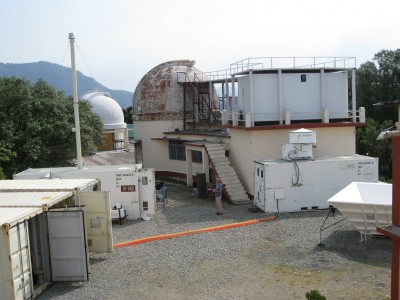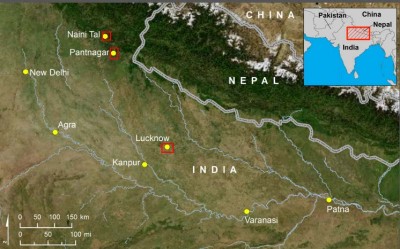Mobile Facility Anchors U.S.-India Collaboration for Cloud-Aerosol Studies
Published: 10 June 2011

The past few decades have seen rapid increases in economic activity in many Asian countries. This is particularly true in countries like India, where new cement factories, steel mills, and power plants fuel the growing economy.
As their economies grow, these countries face similar environmental problems encountered by the developed countries of the west and Japan. Documented increases in aerosol burden over India—and the Ganges Valley region in particular—during the past two to three decades correspond to increasing economic growth in this region.
The consequences of increased soot and dust over India’s Ganges Valley and to the monsoons that sustain agriculture and provide much of the fresh water in the region are relatively unknown. Some studies suggest that globally increasing greenhouse gas emissions combined with regional increases in aerosols could increase the intensity of the monsoons, while other studies suggest they could dry up.
In June, the ARM Mobile Facility began obtaining measurements of clouds, aerosol, precipitation, and radiative energy at Nainital, India, for the Ganges Valley Aerosol Experiment, or GVAX. Data from this nine-month deployment will be used by researchers to study how aerosols affect clouds, including the transfer of energy and rainfall.
“India isn’t the only place with these kinds of conditions,” said Rao Kotamarthi, a scientist at Argonne National Laboratory and the lead scientist for the study. “The global implications of changes in precipitation patterns are a concern for many regions around the world that rely heavily on seasonal rainfall.”
In choosing a location for this type of study, Kotamarthi considered prior research efforts and existing scientific capabilities. The Aryabhatta Research Institute of Observational Sciences, or ARIES, Observatory in Nainital met all the criteria for a successful field campaign using the ARM Mobile Facility’s extensive instrument suite.
“Because the Gangetic Basin experiences a mixture of various aerosol types throughout the seasons, it is an ideal location to study how aerosols impact clouds and energy transfer in the atmosphere,” said Dr. S. K. Satheesh, associate professor at the Indian Institute of Science, Bangalore, and the point of contact for the project in India.
“Data from GVAX will allow us to test hypotheses such as whether warming by black carbon aerosols will reduce cloud cover and whether certain changes in atmospheric chemistry will hinder the ability of clouds to form on aerosol particles,” added Prof. Ram Sagar, Director of ARIES and co-investigator for the project.
Once the location in Nainital was agreed upon, the collaboration was formalized through a Memorandum of Understanding for Cooperation in Atmospheric Radiation Measurement between the Indian Institute of Science and the Aryabhatta Research Institute of Observational Science and the United States Department of Energy.
Measurement Platforms and Sites

All the AMF instruments, including several new ones funded by the American Recovery and Reinvestment Act that have never been deployed before, will operate continuously at the ARIES Observatory in Nainital throughout the field campaign. Site technicians will also launch weather balloons from the site several times a day.
Two more measurement sites will join the study in January 2012. A Mobile Aerosol Observing System, also provided by the ARM Facility, will be deployed in Lucknow, a metropolis in the Ganges Valley region. This system consists of two customized 20-foot shipping containers, each with nearly a dozen instruments specifically designed to obtain measurements of the physical and chemical properties of aerosols and atmospheric gases. This new system is currently undergoing integration and testing at Brookhaven National Laboratory.
At Pantnagar, just south of Nainital, additional ground-based remote sensing instruments provided through DOE’s Atmospheric System Research program and India’s Institute of Science will join together to form an observational “aerosol supersite.”
Then, in February and April, a Beechraft-20 research aircraft from the Indian Space Research Organization (ISRO) will fly over the sites to take direct measurements from the sky.
In support of this comprehensive effort between the two countries, ISRO issued this statement:
“The ISRO Department of Space (DOS) has been intensively pursuing a scientific project ARFI (Aerosol Radiative Forcing over India) for regional characterization of atmospheric aerosols and to assess their climate impacts over south Asia, using a national network of observatories and multi-platform field experiments, as a part of its Geosphere, Biosphere Program. Based on some new region-specific results from these studies, the ISRO—jointly with the Indian Institute of Science (IISc) and Department of Science and Technology (DST)—shaped a major research initiative RAWEX (Regional Aerosol Warming Experiment), implemented through the Space Physics Laboratory of ISRO. It involves several Himalayan observation stations, balloons, and research aircraft.
“In the meantime, the Department of Energy (DOE), USA, approved the interdepartmental Indo-U.S. collaborative research experiment, Ganges Valley Aerosol Experiment (GVAX), involving overlapping scientific interests and collocated measurements of aerosol and atmospheric parameters using a set of state-of-the-art advanced scientific instruments from 2011. The comprehensive investigation between RAWEX and GVAX takes full advantage of the two countries’ overlapping scientific interest, advanced observational capabilities, ongoing atmospheric aerosol research activities in India, and scientific expertise.
“The ISRO/DOS, the lead agency in collaboration with DST & IISc, expect that this mutually enriching cooperation will result in a major step forward in quantifying the climate implications of aerosols globally, in general, and over South Asia, in particular,” said Dr. K. Krishnamoorthy, Director of the Space Physics Laboratory of ISRO and Project Director for ARFI_RAWEX.
The ARM Climate Research Facility is a DOE Office of Science user facility. The ARM Facility is operated by nine DOE national laboratories, including .
Keep up with the Atmospheric Observer
Updates on ARM news, events, and opportunities delivered to your inbox
ARM User Profile
ARM welcomes users from all institutions and nations. A free ARM user account is needed to access ARM data.



















